Practice Free DP-700 Exam Online Questions
Note: This question is part of a series of questions that present the same scenario. Each question in the series contains a unique solution that might meet the stated goals. Some question sets might have more than one correct solution, while others might not have a correct solution.
After you answer a question in this section, you will NOT be able to return to it. As a result, these questions will not appear in the review screen.
You have a Fabric eventstream that loads data into a table named Bike_Location in a KQL database.
The table contains the following columns:
– BikepointID
– Street
– Neighbourhood
– No_Bikes
– No_Empty_Docks
– Timestamp
You need to apply transformation and filter logic to prepare the data for consumption. The solution must return data for a neighbourhood named Sands End when No_Bikes is at least 15. The results must be ordered by No_Bikes in ascending order.
Solution: You use the following code segment:

Does this meet the goal?
- A . Yes
- B . no
B
Explanation:
This code does not meet the goal because this is an SQL-like query and cannot be executed in KQL, which is required for the database.
Correct code should look like:

HOTSPOT
You need to ensure that the data engineers are notified if any step in populating the lakehouses fails.
The solution must meet the technical requirements and minimize development effort.
What should you use? To answer, select the appropriate options in the answer area. NOTE: Each correct selection is worth one point.
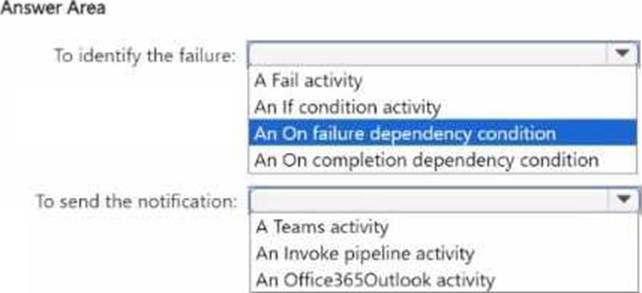
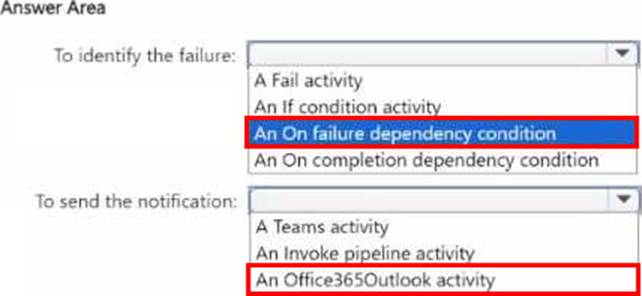
HOTSPOT
You are building a data orchestration pattern by using a Fabric data pipeline named Dynamic Data Copy as shown in the exhibit. (Click the Exhibit tab.)

Dynamic Data Copy does NOT use parametrization.
You need to configure the ForEach activity to receive the list of tables to be copied.
How should you complete the pipeline expression? To answer, select the appropriate options in the answer area. NOTE: Each correct selection is worth one point.


HOTSPOT
You plan to process the following three datasets by using Fabric:
• Dataset1: This dataset will be added to Fabric and will have a unique primary key between the source and the destination. The unique primary key will be an integer and will start from 1 and have an increment of 1.
• Dataset2: This dataset contains semi-structured data that uses bulk data transfer. The dataset must be handled in one process between the source and the destination. The data transformation process will include the use of custom visuals to understand and work with the dataset in development mode.
• Dataset3. This dataset is in a takehouse. The data will be bulk loaded. The data transformation process will include row-based windowing functions during the loading process.
You need to identify which type of item to use for the datasets. The solution must minimize development effort and use built-in functionality, when possible.
What should you identify for each dataset? To answer, select the appropriate options in the answer area. NOTE: Each correct selection is worth one point.
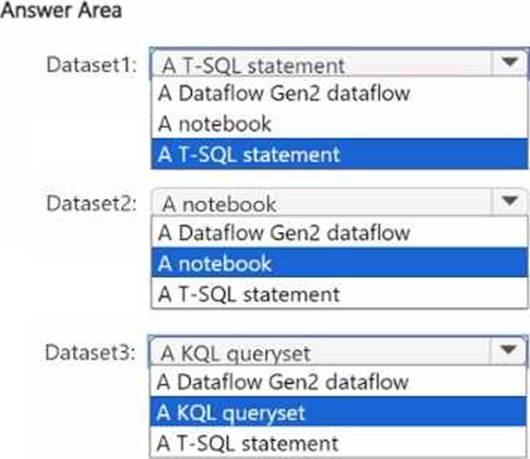
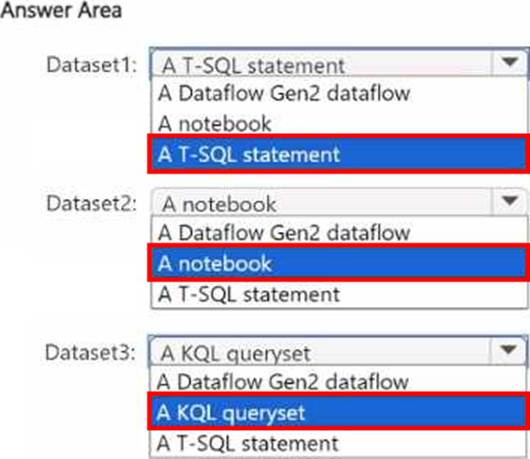
You have a Fabric workspace that contains a lakehouse named Lakehouse1.
In an external data source, you have data files that are 500 GB each. A new file is added every day.
You need to ingest the data into Lakehouse1 without applying any transformations.
The solution must meet the following requirements
Trigger the process when a new file is added.
Provide the highest throughput.
Which type of item should you use to ingest the data?
- A . Event stream
- B . Dataflow Gen2
- C . Streaming dataset
- D . Data pipeline
A
Explanation:
To ingest large files (500 GB each) from an external data source into Lakehouse1 with high throughput and to trigger the process when a new file is added, an Eventstream is the best solution.
An Eventstream in Fabric is designed for handling real-time data streams and can efficiently ingest large files as soon as they are added to an external source. It is optimized for high throughput and can be configured to trigger upon detecting new files, allowing for fast and continuous ingestion of data with minimal delay.
Note: This question is part of a series of questions that present the same scenario. Each question in the series contains a unique solution that might meet the stated goals. Some question sets might have more than one correct solution, while others might not have a correct solution.
After you answer a question in this section, you will NOT be able to return to it. As a result, these questions will not appear in the review screen.
You have a Fabric eventstream that loads data into a table named Bike_Location in a KQL database.
The table contains the following columns:
– BikepointID
– Street
– Neighbourhood
– No_Bikes
– No_Empty_Docks
– Timestamp
You need to apply transformation and filter logic to prepare the data for consumption. The solution must return data for a neighbourhood named Sands End when No_Bikes is at least 15. The results must be ordered by No_Bikes in ascending order.
Solution: You use the following code segment:

Does this meet the goal?
- A . Yes
- B . no
A
Explanation:
Filter Condition: It correctly filters rows where Neighbourhood is "Sands End" and No_Bikes is greater than or equal to 15.
Sorting: The sorting is explicitly done by No_Bikes in ascending order using sort by No_Bikes asc.
Projection: It projects the required columns (BikepointID, Street, Neighbourhood, No_Bikes, No_Empty_Docks, Timestamp), which minimizes the data returned for consumption.
HOTSPOT
You have a Fabric workspace that contains an event stream named EventStream1. You discover that an EventStream1 transformation fails. You need to find the following error information:
The error details, including the occurrence time
The total number of errors
What should you use? To answer, select the appropriate options in the answer area. NOTE: Each correct selection is worth one point.
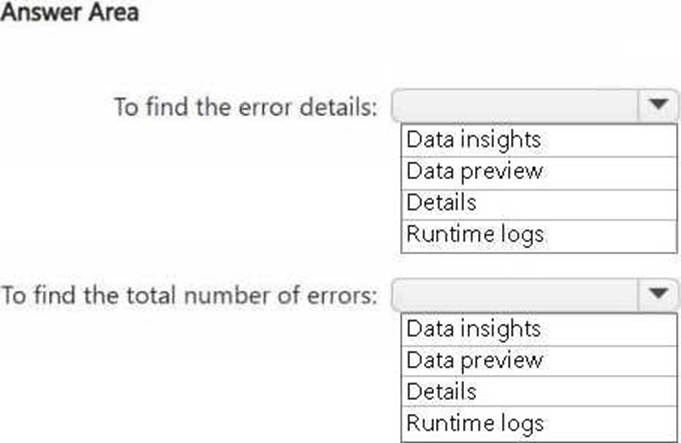
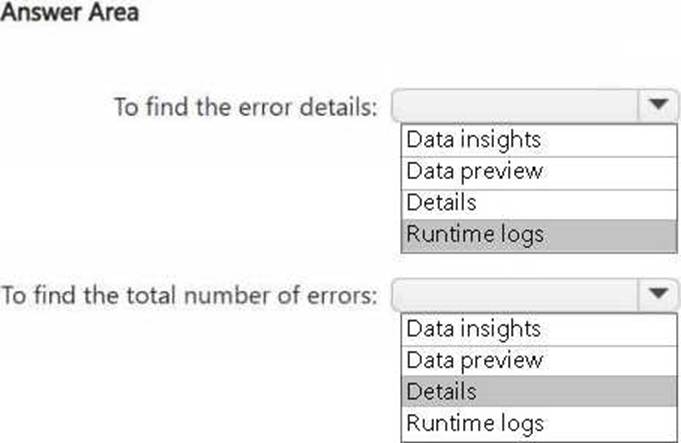
You have a Fabric workspace that contains a Real-Time Intelligence solution and an eventhouse.
Users report that from OneLake file explorer, they cannot see the data from the eventhouse.
You enable OneLake availability for the eventhouse.
What will be copied to OneLake?
- A . only data added to new databases that are added to the eventhouse
- B . only the existing data in the eventhouse
- C . no data
- D . both new data and existing data in the eventhouse
- E . only new data added to the eventhouse
D
Explanation:
When you enable OneLake availability for an eventhouse, both new and existing data in the eventhouse will be copied to OneLake. This feature ensures that data, whether newly ingested or already present, becomes available for access through OneLake, making it easier for users to interact with and explore the data directly from OneLake file explorer.
You have a Fabric F32 capacity that contains a workspace. The workspace contains a warehouse named DW1 that is modelled by using MD5 hash surrogate keys.
DW1 contains a single fact table that has grown from 200 million rows to 500 million rows during the past year.
You have Microsoft Power BI reports that are based on Direct Lake. The reports show year-over-year values.
Users report that the performance of some of the reports has degraded over time and some visuals show errors.
You need to resolve the performance issues.
The solution must meet the following requirements:
Provide the best query performance.
Minimize operational costs.
Which should you do?
- A . Change the MD5 hash to SHA256.
- B . Increase the capacity.C Enable V-Order
- C . Modify the surrogate keys to use a different data type.
- D . Create views.
C
Explanation:
In this case, the key issue causing performance degradation likely stems from the use of MD5 hash surrogate keys. MD5 hashes are 128-bit values, which can be inefficient for large datasets like the 500 million rows in your fact table. Using a more efficient data type for surrogate keys (such as integer or bigint) would reduce the storage and processing overhead, leading to better query performance. This approach will improve performance while minimizing operational costs because it reduces the complexity of querying and indexing, as smaller data types are generally faster and more efficient to process.
HOTSPOT
You need to troubleshoot the ad-hoc query issue.
How should you complete the statement? To answer, select the appropriate options in the answer area. NOTE: Each correct selection is worth one point.
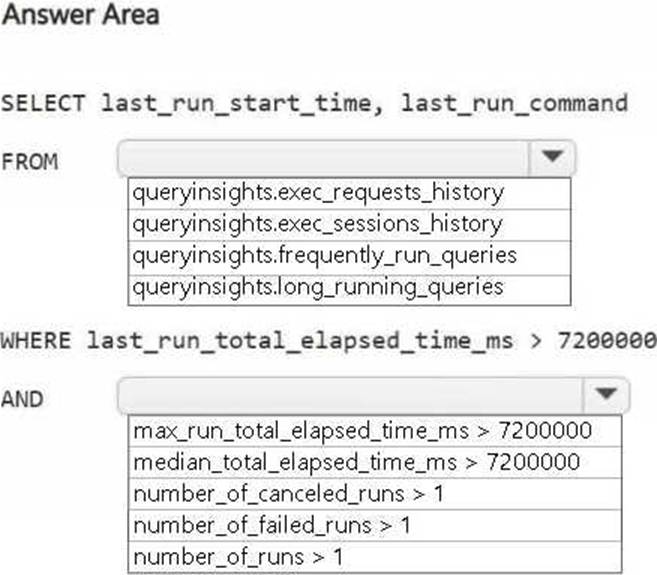
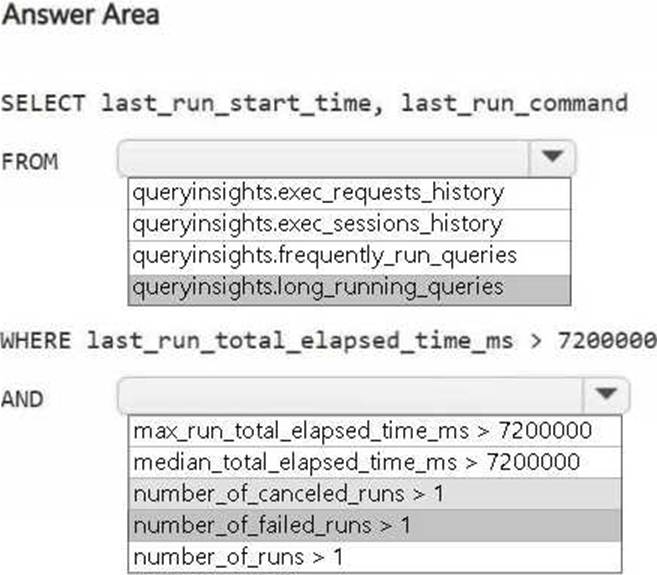
Explanation:
A screenshot of a computer Description automatically generated
SELECT last_run_start_time, last_run_command: These fields will help identify the execution details of the long-running queries.
FROM queryinsights.long_running_queries: The correct solution is to check the long-running queries using the queryinsights.long_running_queries view, which provides insights into queries that take longer than expected to execute.
WHERE last_run_total_elapsed_time_ms > 7200000: This condition filters queries that took more than 2 hours to complete (7200000 milliseconds), which is relevant to the issue described.
AND number_of_failed_runs > 1: This condition is key for identifying queries that have failed more than once, helping to isolate the problematic queries that cause failures and need attention.
